
Andreas Schlüter was a German baroque sculptor and architect, active in the Holy Roman Empire of the German Nation, the Polish–Lithuanian Commonwealth, and the Russian Tsardom.

Stanisław II August, known also by his regnal Latin name Stanislaus II Augustus, and as Stanisław August Poniatowski, was King of Poland and Grand Duke of Lithuania from 1764 to 1795, and the last monarch of the Polish–Lithuanian Commonwealth.

The Royal Castle in Warsaw is a state museum and a national historical monument, which formerly served as the official royal residence of several Polish monarchs. The personal offices of the king and the administrative offices of the royal court were located in the Castle from the 16th century until the final partition of Poland in 1795. Situated in the Castle Square, at the entrance to the Old Town, the Royal Castle holds a significant collection of Polish and European art.
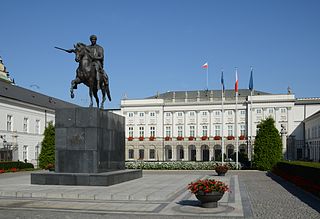
The Presidential Palace is the official residence of the Polish head of state and president alongside the Belweder Palace, located in Warsaw, Poland. Originally constructed in 1643 as an aristocratic mansion, it was rebuilt and remodelled several times over the course of its existence by notable architects. The current neoclassical palace was completed in 1818.
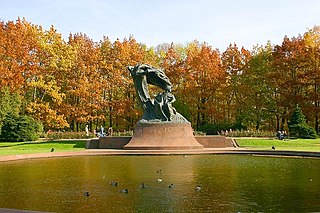
Łazienki Park or Royal Baths Park is the largest park in Warsaw, Poland, occupying 76 hectares of the city center. The park-and-palace complex lies in the Downtown district, on Ujazdów Avenue, which is part of the Royal Route linking the Royal Castle with Wilanów Palace to the south.
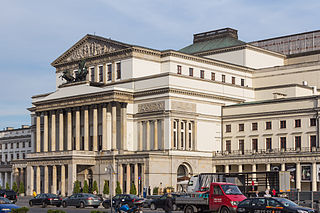
The National Theatre in Warsaw, Poland, was founded in 1765, during the Polish Enlightenment, by that country's monarch, Stanisław August Poniatowski. The theatre shares the Grand Theatre complex at the Theatre Square in Warsaw with another national venue, the Poland's National Opera.

Francesco the "Florentine" was an Italian Renaissance sculptor from Florence. His date of birth is unknown. He died on 16 October 1516 in Kraków.
Events from the year 1733 in art.

Marcello Bacciarelli was an Italian-born painter of the late-baroque and Neoclassic periods active in Poland and the Polish–Lithuanian Commonwealth.
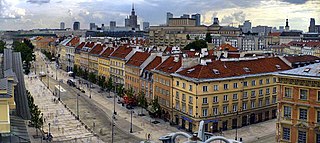
Krakowskie Przedmieście is one of the best known streets of Poland's capital Warsaw, surrounded by historic palaces, churches and manor-houses. It constitutes the northernmost part of Warsaw's Royal Route, and links the Old Town and Royal Castle with some of the most notable institutions in Warsaw, including, proceeding southward, the Presidential Palace, Warsaw University, and the Polish Academy of Sciences headquartered in the Staszic Palace. The immediate southward extension of the street along the Royal Route is New World Street.

The Palace on the Isle, also known as the Baths Palace, is a classicist palace in Warsaw's Royal Baths Park, the city's largest park, occupying over 76 hectares of the city center.
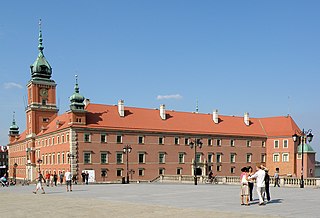
The Royal Castle in Warsaw was a seat of the Sejm and Senate of the first Rzeczpospolita and also an official residence of the monarchs in Warsaw. It contained the offices of a number of political institutions, arranged around a central courtyard.

St. Anne's Church is a church in the historic center of Warsaw, Poland, adjacent to the Castle Square, at Krakowskie Przedmieście 68. It is one of Poland's most notable churches with a Neoclassical facade. The church ranks among Warsaw's oldest buildings. Over time, it has seen many reconstructions, resulting in its present-day appearance, unchanged since 1788. Currently it is the main church parish of the academic community in Warsaw.
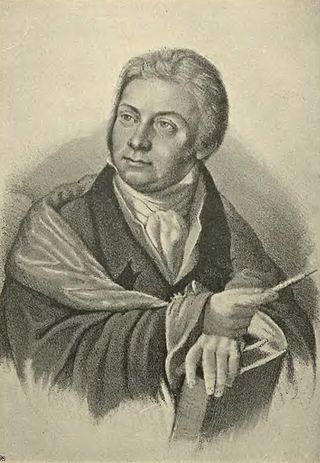
Zygmunt Vogel was a Polish illustrator, educator, and painter in the classical style. He was sometimes called Ptaszek : a reference to his name and to the many years that he traveled almost continuously.

André Beauneveu was an Early Netherlandish sculptor and painter, born in the County of Hainaut, who is best known for his work in the service of the French King Charles V, and of the Valois Duke, Jean de Berry. His work in all media shows a generally naturalistic and 'sculptural' style, characteristic of the 'Pucellian revival' of the latter 14th century.

Jan Chryzostom Redler, also Johann Chrysostomus Redler, was a Polish sculptor. His exact date of birth or death is not known. He worked mainly in Warsaw and Białystok.

Jakub Fontana was a Polish architect of Swiss Italian origin, a practitioner of the Baroque and Neoclassical styles. He was court architect to the Polish king. He was knighted in 1764. Jakub Fontana had a notable brother named Jan Kanty Fontana. His projects were influenced by Saxon Baroque, French Rococo and early Neoclassicism.

Ludwik Marteau, originally Louis-François Marteau was a Polish court painter who served under kings Augustus III and Stanisław August Poniatowski. All of his known works are portraits; both full size and miniatures.
Piotr Triebler (1898–1952), was a Polish sculptor whose works are associated with Kuyavian-Pomeranian Voivodeship in general and with Bydgoszcz in particular.

An equestrian statue of Charles II trampling Cromwell stands near Newby Hall in North Yorkshire, England. It was previously sited at Gautby Hall in Lincolnshire, and was originally installed at the Stocks Market in the City of London. It is a Grade II listed building.


















